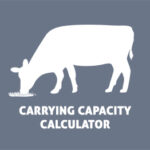How to Calculate Your Carrying Capacity ▶️
What is carrying capacity, and what does it mean for your farm?
Carrying capacity, also known as grazing capacity, is the amount of forage a specific pasture produces that is available for grazing animals. Determining a long-term, sustainable carrying capacity for a pasture is a key component of balancing forage supply and forage demand and is developed over a long period of time.
The Beef Cattle Research Council has developed the following video to help producers assess and manage carrying capacity.
The amount of available forage depends on the type of plant species, climate, overall condition of the pasture and many other factors. Is the pasture in good condition with abundant carryover from the past season? Or is the tame pasture stand older and the production potential is reduced?
The demand for forage varies by the type of cattle grazing. For example, yearlings graze approximately 30 percent less forage than cow-calf pairs.
Four Principles of Grazing Management
Whether you are grazing tame grass or native prairie, there are four basic ground rules of grazing management. (0:32)
- Balance forage supply and demand (0:40)
- Avoid grazing during sensitive time periods (0:44)
- Manage your livestock distribution (1:04)
- Provide effective rest for plants during the growing season (1:25)
Remember, “it takes grass to make grass.” It’s important to manage utilization so that you have carryover on your pastures which can prevent you from having to destock unexpectedly. (1:39)
The BCRC Carrying Capacity Calculator
The BCRC Carrying Capacity Calculator is an interactive tool allowing producers to determine carrying capacity of pastures based on two different methods:
Method 1 (2:15) uses regional forage production benchmarks to help producers estimate forage production potential based on their annual rainfall, pasture condition and other parameters. Find additional provincial published recommendations of forage estimates.
Method 2 (2:24) is a more “hands-on” approach which involves clipping, drying and weighing forage samples that are representative of the pasture to determine how much forage is available.
You can’t fit mother nature into a box, but this calculator can serve as a starting point to help you find a sustainable carrying capacity for your farm.
LEARN MORE
- Carrying Capacity Calculator (BCRC interactive tool)
- Two Methods, Four Steps for Calculating Carrying Capacity (BCRC post)
- Carrying or Grazing Capacity (BCRC post)
- Cracking the Code on Grazing Management Terminology: Animal Units, AUMS, & How to Apply Them (BCRC post)
- This Grazing Season, Remember the Four Principles of Pasture Management (BCRC post)
- Grazing Management (BCRC topic page)
- Rangeland and Riparian Health (BCRC topic page)
- Forested Rangeland Grazing (BCRC topic page)
- Grazing Game Plan – How to Develop a Grazing Plan (BCRC webinar)
Sharing or reprinting BCRC posts is welcome and encouraged. Please credit the Beef Cattle Research Council, provide the website address, www.BeefResearch.ca, and let us know you have chosen to share the article by emailing us at [email protected].
Your questions, comments and suggestions are welcome. Contact us directly or spark a public discussion by posting your thoughts below.
